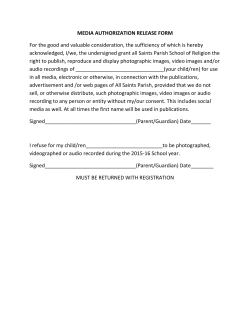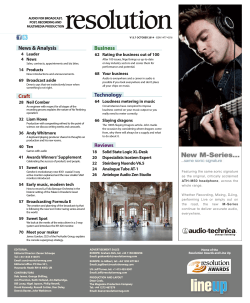
Digital Secured Audio Watermarking With Providing High
International Journal of Innovative and Emerging Research in Engineering Volume 2, Issue 5, 2015 Available online at www.ijiere.com International Journal of Innovative and Emerging Research in Engineering e-ISSN: 2394 – 3343 p-ISSN: 2394 – 5494 Digital Secured Audio Watermarking With Providing High Perception Capacity Nidhi H Patel1 , Ravi K Sheth2 Student of M.E. (ITSNS)1 , Assistant Professor (IT)2 GTU PG School/Gujarat Technological University1 , Raksha Shakti University2 nidhi.it25@gmail.com1 , ap.it@rakshashaktiuniversity.edu.in2 ABSTRACT: Audio Watermarking is the process of inserting secret data into multimedia data in a way that the quality degradation is minimized and remain at an imperceptible level. Many digital watermarking algorithms have been proposed in frequency and transform domains. Some transforms such as DCT and DWT are used for watermarking in the frequency domain. In this work, we have proposed solution based the DCT watermarking using Arnold Transformation related to capacity criteria. Keywords : Audio Watermarking , MP3 , Arnold Transformation , capacity I. INTRODUCTION In recent years, due to the growth of networked multimedia systems and the widespread use of personal computers, people have easy access to vast amounts of copyrighted digital data. This data, which includes text, digital audio, image and video, offers various advantages.[2] They can be reproduced without loss of quality, shared by multiple users, distributed over networks, and managed for long periods of time without any damage. However, unauthorized copying and distribution of digital data are serious threats to the rights of content owners.[3] Therefore, digital data protection and copyright issues have become more and more important in the face of today’s technology. As a solution to copyright protection issues, digital watermarking technology is gaining attention as a new method of protecting copyrights for digital data.[4] Digital watermarking is the technique of inserting specific information (watermark) into audio signal, data, image or video. The specific information is known as watermark and usually used for ownership verification, identification, authentication purpose and protection.[5] Many watermarking algorithms have been reported in the literature. Most of them were developed for digital images and videos data; interest and research in audio watermarking started slightly later. Compared to digital video and image watermarking, audio watermarking algorithms are not easy to develop because of the human auditory system (HAS) is extremely more sensitive than human visual system (HVS). [6] Audio clips are rather short compared with video clips in terms of time and file size. Thus, the amount of hidden information in audio clips is relatively large compared with the image or video. [7] In this paper, unlike the other methods that change the useful bit, we use the private bit of the frame header as an index which shows whether the first n bits in the frame equals to the watermark. We use index list for store and retrieval purpose. We encrypt the secret message using Arnold transform and segment the watermark code sequences to sections with n bits (this paper takes, n=2). This idea was motivated by the fact that in [1], the private bit in the frame header can be changed without interrupting the coding process of MP3 files. This paper is outlined as follows: The proposed method will be introduced in section II in detail. In section III, some experimental results will be listed. Finally, section IV contains the conclusions. II. Watermarking Scheme A. Watermark Embedding Procedure: Step1 : First step is to check that, the audio clip which we are using for cover signal that file is actual MP3 file or not. If the header of cover signal consists of a sync word, it is used to identify the beginning of a valid frame. This is followed by a bit indicating that this is the MPEG standard and two bits that indicate that layer3 is used; hence MPEG-1 Audio Layer 3 or MP3. After this, the values will differ, depending on the MP3 file. This is to verify that the audio clip is genuine MP3 file. Step2 : convert audio clip from analogue signal to binary format for further processing. Stpe3 : At the same side convert jpeg secret data into Greyscale form. And apply Arnold transformation to provide better security of secret data. 1 International Journal of Innovative and Emerging Research in Engineering Volume 2, Issue 5, 2015 Step4 : Read n bits (n=2 in our system) in sequence form pre-processed secret data. Compare the bits with the firs n bits data in the main data in cover signal, if they are the same, set the private bit to ‘1’, else keep it with ‘0’ and find the next MP3 frame. Step5 : make list of index which contain all the index number where secret data is stored. Step6 : Do Step4 to Step5 repeatedly until the entire secret bits are completely embedded into cover signal. Figure 1: Watermark Embedding B. Watermark Reconstruction Procedure: The secret message is reconstructed from the watermarked MP3 files by subsequent the embedding algorithm in overturn order. Figure 2 illustrates the pursued steps to extract the hidden information and reconstruct the secret message. Step1 : The first step divide Audio clip in to frame and further processing is done frame by frame. Step2 : Second step consists of checking the private bit of the Embedded MP3 file frame. If Privet bit is set to '1' then extracts Data from Index list. Step3 : Rearrange the Data to form a patchwork which lastly be transformed by Inverse Arnold transform to get the original secret message. Figure 2: Watermark Extraction 2 International Journal of Innovative and Emerging Research in Engineering Volume 2, Issue 5, 2015 III. Experimental Results We have experiment this procedure. These are waveform shown in figure3. First waveform is original MP3 file which is used to transmit data and Second waveform is watermark embedded MP3 file which include secret data. Figure 3: (1) Original MP3 File (2) Embedded MP3 File First sequence is the original input Sequence of JPEG image file. Second sequence is form by Applying Arnold Transformation for Encryption of Secret Data. Third sequence is generate when we apply Inverse Arnold Transformation to Extract Secret Data. Figure 4: (1) Original input sequence of JPEG Image file (2)Sequence after Arnold Transformation is applied (3)Sequence after Inverse Arnold Transformation is applied to reconstruct JPEG image This is the actual output of our experiment. First Image is original secret data which is to be embedded into cover signal. Second one is Transformed watermark that generated by Arnold transformation which is used in transmission. Third one is reconstructed at the receiver's side by applying Inverse Arnold Transformation. Figure 5: (1) Original Watermark (2) Transformed Watermark (3) Reconstructed Watermark IV. Conclusion The performance of the algorithm is provided by evaluating the performance parameters such as capacity, imperceptibility, and robustness. The proposed algorithm is based on quantization in DCT domains and considering the more active components of the signal is Arnold Transformation. In this work we have tried to embed watermark data in small audio clip by reusing the file. So that Capacity is increased. The proposed system will provide accurate and valuable result as par what we want in Capacity criteria. In further works, we will focus on improving the robustness. [1] [2] [3] [4] References Yang, Bailong, et al. "Lossless and secure watermarking scheme in MP3 audio by modifying redundant bit in the frames." Information Management, Innovation Management and Industrial Engineering (ICIII), 2013 6th International Conference on. Vol. 1. IEEE, 2013. Elshazly, A. R., M. M. Fouad, and M. E. Nasr. "Secure and robust high quality DWT domain audio watermarking algorithm with binary image." Computer Engineering & Systems (ICCES), 2012 Seventh International Conference on. IEEE, 2012. Kabir, Hussain Mohammed Dipu, and Syed Bahauddin Alam. "Hardware based realtime, fast and highly secured speech communication using FPGA."Information Theory and Information Security (ICITIS), 2010 IEEE International Conference on. IEEE, 2010. Himeur, Yassine, and Bachir Boudraa. "Secure and robust audio watermarking system for copyright protection." Microelectronics (ICM), 2012 24th International Conference on. IEEE, 2012. 3 [5] [6] [7] International Journal of Innovative and Emerging Research in Engineering Volume 2, Issue 5, 2015 Adya, Muneish. "Audio watermark resistant to mp3 compression". Diss. INDIAN INSTITUTE OF TECHNOLOGY KHARAGPUR, INDIA, 2007. Ravula, Rajkiran. "Audio watermarking using transformation techniques". Diss. Faculty of the Louisiana State University and Agricultural and Mechanical College in partial fulfillment of the requirements for the degree of Master of Science in Electrical Engineering in The Department of Electrical and Computer Engineering by Rajkiran Ravula Bachelor of Engineering in Electrical and Electronics Engineering, Osmania University, 2010. Chandra, Munesh, Shikha Pandey, and Rama Chaudhary. "Digital watermarking technique for protecting digital images." Computer Science and Information Technology (ICCSIT), 2010 3rd IEEE International Conference on. Vol. 7. IEEE, 2010. 4
© Copyright 2025














